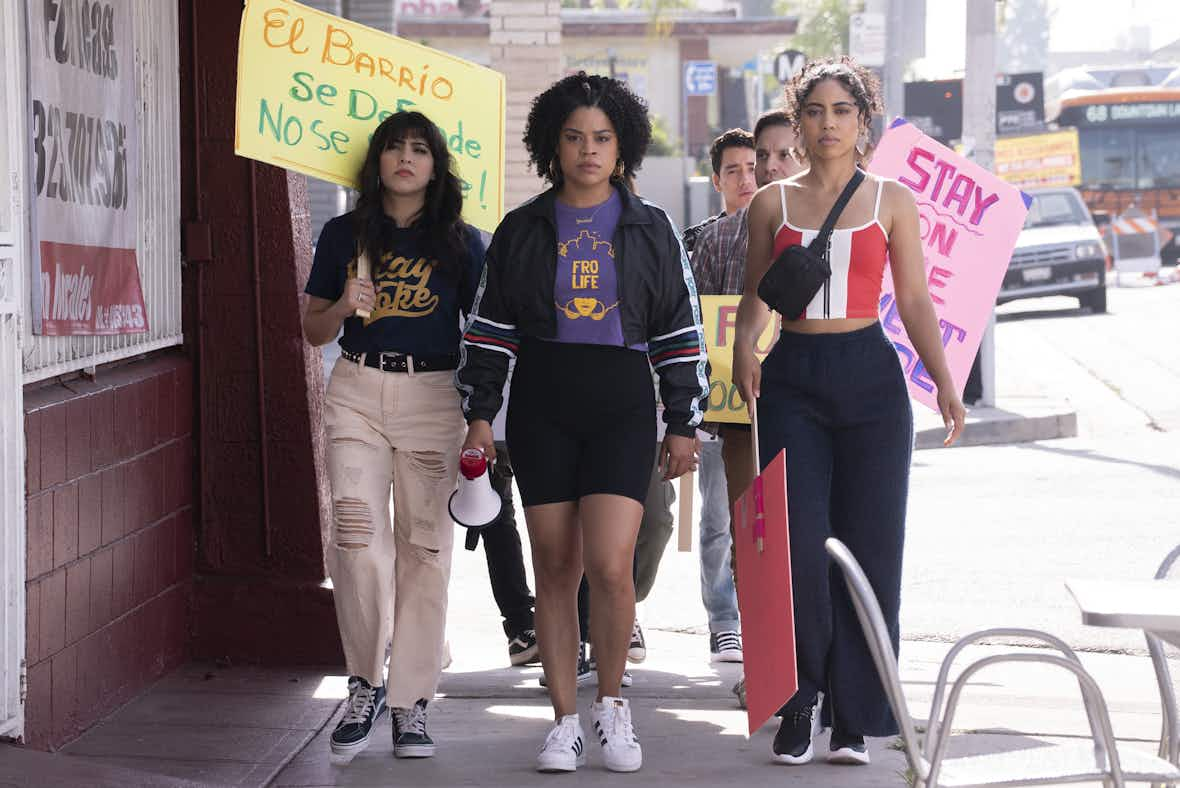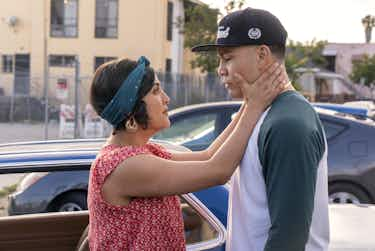Gentefied: the show grappling with gentrification in Latinx LA

A new Netflix series skewers the way white people encroach on traditionally Latinx neighbourhoods, as well as how business owners must cater to outsiders in order to survive.
Culture
Words: Paola de Varona
There’s a scene in the new Netflix show Gentefied, a bilingual dramedy set in East LA, that perfectly sums up the series’ ability to toy with satire while invoking a sense of urgency.
“Come take a bite of Boyle Heights…” Erik says into the camera, dressed like a Latinx caricature with a bandana tied tight across his forehead and a drawing of a teardrop tattoo on his cheek. “… Before it’s gone.”
Erik is one of three cousins involved in the recording of a social media ad for their grandfather’s taco shop ahead of its participation in the Boyle Heights taco crawl – a palatable “ethnic” event for food-blogging wypipo.
To garner support for the event, they decide to give white participants a performance in the video: an “authentic experience” of a struggling Latinx business in Los Angeles’ predominantly Latinx neighbourhood, complete with a fake anti-gentrification protest.
The showrunners know that gentrification is a hot button issue, and with a wink and nod, they have their actors say it to your face.
Gentefied, out now on Netflix, follows three cousins fighting to keep the popular Mama Fina’s taco shop in business as developers set their sights on the neighbourhood.
The three couldn’t be more different: Erik is an outwardly macho man, who checks out books on how to express love; Chris is an aspiring Michelin-star chef, returning from college in Idaho; and Ana is a struggling queer artist. Throughout the first season, the cousins butt heads on their differing relationships with their heritage, while confronting gentrification and class inequality head on in east LA.
At the centre of this conversation sits Boyle Heights. For years, the real life local activist group Defend Boyle Heights garnered attention for their protests against the displacement of low-income residents. The 2018 show Vida also focused on the neighbourhood, but the organisation disavowed the series for exploiting their anti-gentrification struggles, calling it “gentrification porn” and threatening to protest at filming locations. The show, now in its second season, follows two sisters from Boyle Heights and the anti-gentrification struggle within the neighborhood. But activists say it distastefully pokes fun at them, while profiting from the same problem the series intends to explore.
Beyond Boyle Heights, Latinx neighborhoods across the US are increasingly at risk of gentrification and displacement. In Chicago’s Pilsen, a historic Mexican community, rents keep rising and Latinx residents are pushed to the suburbs. Miami’s Little Havana, once a quiet working-class Cuban neighborhood, is now flooded with double decker tourist buses. The Puerto Rican population in New York neighborhoods like Williamsburg and Bushwick has shrunk dramatically over the past five to 10 years.
Gentefied aims to approach mass gentrification differently. The show’s name seems like a clever mix between gentrification and gente (“people” in Spanish). But it’s actually a pre-existing term referring to middle-class Latinxs – often younger, with higher degrees of education – who return to their barrios and begin economic development. Proponents of gentefication tout upwardly mobile Latinxs investing in their communities as a way to preserve their culture through innovation. Think “gluten-free tacos” and bars flaunting Mariachi karaoke nights, better known as Marioke. (Yes, this exists.)

Typically, gentrification is thought of simply as rich white people’s doing. But what about when it’s self-inflicted? Take Chris’s character as a case study. Moves back home after living abroad having accrued wealth and knowledge? Check. Adopts white, yuppie culture as his own, and therefore isn’t considered “Mexican enough” by his family and coworkers? Check. Suggestions for Mama Fina’s revitalisation include staff cuts, price increases, and catering to hipsters? Check. The man tries to sell chicken tikka masala tacos to regular customers when all they want is a no frills taqueria.
At first glance, the influence of gentefiers like Chris may seem like a positive development, and indeed many Latinx business owners and developers strive to preserve the culture of their neighbourhoods while innovating and revitalising business. But these efforts often fail to retain the integrity of the shop and, in turn, el barrio. By catering to a more white, yuppie crowd, gentefiers like Chris make neighbourhoods like Boyle Heights a digestible experience for white consumers. Ethnicity and authenticity become tied up neatly as a product.
With the purchase of a ticket to the Boyle Heights taco crawl, “hip” consumers are advertised a guilt-free entry pass to the frontlines of social change. They were sold the image of the hard-working immigrant and small-business owner that just want a better life for their kids; after all, the only depiction optimal for this transaction is the non-threatening Latinx that merely desires survival, never asking for more than they’re given.
Ana’s character represents a different side of the struggle. She works at both the taco shop and a nearby bar, and also sells her artwork on the side to supplement her mother’s factory wages. She’s constantly volunteering with her girlfriend Yessika’s local grassroots movements and is a loud voice for the community. That is, until a white developer seeks out her art. Soon, she’s being paid $4,000 for her murals across town. Local business owners decry her progressive, unapologetically queer work on their buildings because it drives away their more conservative-minded regulars. But ultimately, it’s the developer’s call to commission her art on more of his newly purchased buildings.
Chicano muralists have historically represented themselves and laid claim to their territory through art in neighbourhoods like Boyle Heights, and Ana is very much a part of that tradition. On the one hand, she affirms her queer, Chicana identities through her murals, but on the other, she works for a white developer, who seeks only to beautify the space as a means to maximize profit. It’s a complicated situation for Ana to grapple with. In one conversation, her girlfriend Yessika puts it best: “White folks love dropping money on authenticity. They may love all our shit, but they don’t love us.”

Gentefied demands we watch its characters flounder in order to understand the difficulties they face when trying to thrive in a system purposefully built to keep them out. A 2018 Stanford study found that immigrants account for one quarter of US entrepreneurs, and the growth of Latinx-owned businesses in particular continues to outpace other groups. Still, Latinx business owners tend to struggle the most with operating expenses and limited access to credit.
In Mama Fina’s case, the cousins must grapple with the reality that regardless of their approach, the business can’t survive on the patronage of local Latinx regulars alone. This isn’t because Latinxs despise change or are resistant to investing in their communities, but because they don’t necessarily have the disposable income to splurge on a $10 burrito. One study found that “in 2011 the median white household had $111,146 in wealth holdings, compared to just […] $8,348 for the median Latino household.”
Economic instability in the community is especially represented in the struggles of Ana, who tries to find success and stability through her art in an industry that rarely celebrates brown artists like her. Choosing between a taking on a commissioned mural and standing up for her community is the difference between having rent money to give her struggling mother and showing up empty-handed.
In this way, Gentefied encapsulates the way Latinxs are forced into survival mode – rarely finding space to chase their passions while also doing right by their community and staying true to their roots. Still there are pockets of hope; for instance, Erik starts a program where local children can earn a taco pro bono for reading a book in the “Mama Fina’s library,” creating loyal and appreciative customers out of their families.
Gentefied leaves us with a reminder that there are still good ways to invest in a community, all of which start by listening to the people in it.

